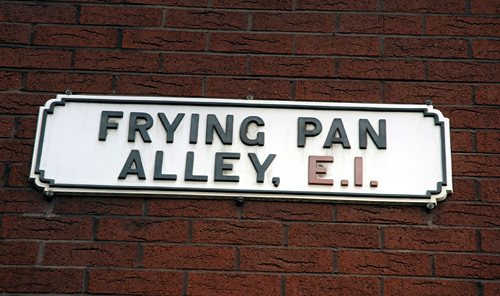Bit late with this but the winner of the What's in a name competition was Jasmine, with this rather stunning entry for Frying Pan Alley, who wins a print of the above picture!
Much like empty fields that attract runaway, cart-napped, old, feeble and/or abandoned shopping carts, this alley is where analogous frying pans traditionally congregate.Its origins are disputed amongst kitchenalia anthropologists. The majority of pot-bound PhDs trace Frying Pan Alley’s (FPA) naissance to the Dark Ages’ ever-popular religious pilgrimages—upon their return from the various cathedrals and grottos, many humans gave up their trusty pans as part of a religious re-awakening and simply allowed their cookware to roam free (or worse, melted down into trivets and door handles); many pans who escaped this fate gravitated towards what became known as “Ye Olde Potte Field”( now known as FPA), looking for others who survived the “the purge of the pots and pans.”
Please note, this group of researchers also believes the reason that era was so, well, dark is because since the pans accompanied (were enslaved to?) people trotting about England, France and wherever else looking relics, there really was no need to keep hearths lit, which decreased the amount of light available (NB: any argument that the decreased amounts of soot spewed during this time should have counterbalanced the decreased number of fires lit is immediately discounted).
Also worthy of note is a small, yet growing number of scientists who believe FPA is the burial grounds for vessels used during Druidic ceremonies, belief held by many pots and pans today. Apparently many (mostly frying pans) treat the area as a shrine or temple: when I asked my cookware about this, all the stovetop pieces knew about it and my frying pans (non-stick *and* cast iron) replied “Well, yeah—it is every pan’s dream to one day visit the Holy Grounds.” My ovenware dismissed it as being a load of hooey “because everyone knows that the real spiritual centre is just off a fjord near Sweden.” Who knew such spiritual differences lay within my cupboards?In the 17th century the area fell into some disrepute with rapidly propagating discount pan shops. Unfortunately, the many pans weren’t well constructed and unhappy cooks took to flinging them through shop windows…and in turn the shop owners would pitch them in their back yards (it is hard to sell a dented pan).
Archaeologists have spent the greater part of the past four years in a 10’x15’ plot where it’s surmised the most disreputable cookware salesman set up shot between 1652-1657; as best as anyone can tell, the actual name (FPA) came into existence about eight years later in 1665. The area has had its ups and downs (in the mid-late 19th century it was quite a chic area, with anyone who wanted to be seen stepping on its cobbles). More recently, in reaction to the unappetizing path the area had taken in the 1980s, city government implemented a scouring program to clean up the area. As a result, it is now a popular place for visiting cookware (being *the* holiday hotspot for sauciers, Dutch ovens and tagines) to go and have their pictures taken.

1 comment:
Whee hee!
Thanks so much :)
j
Post a Comment